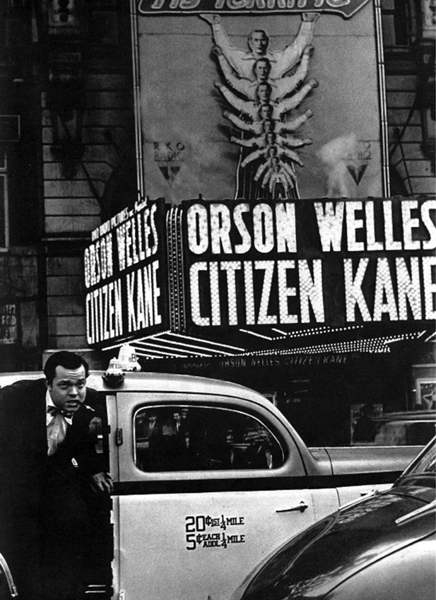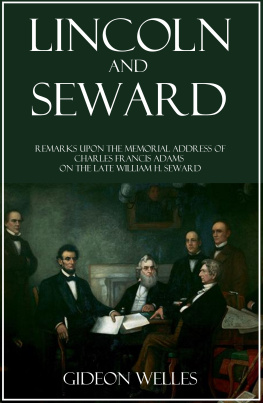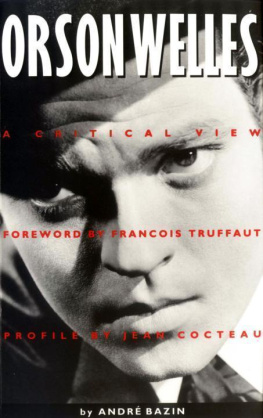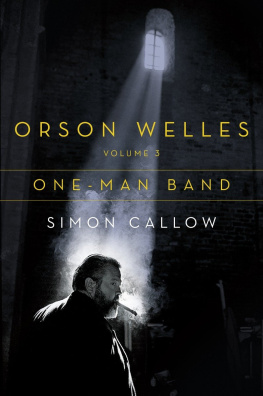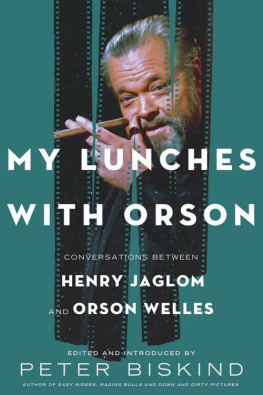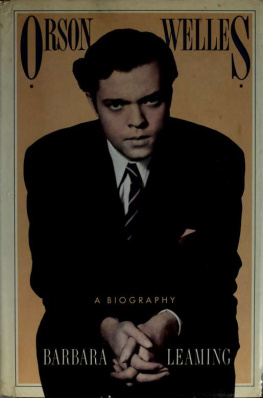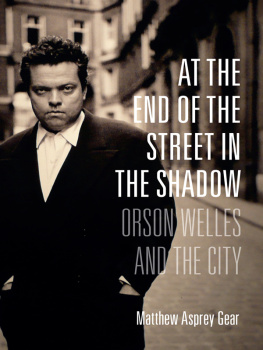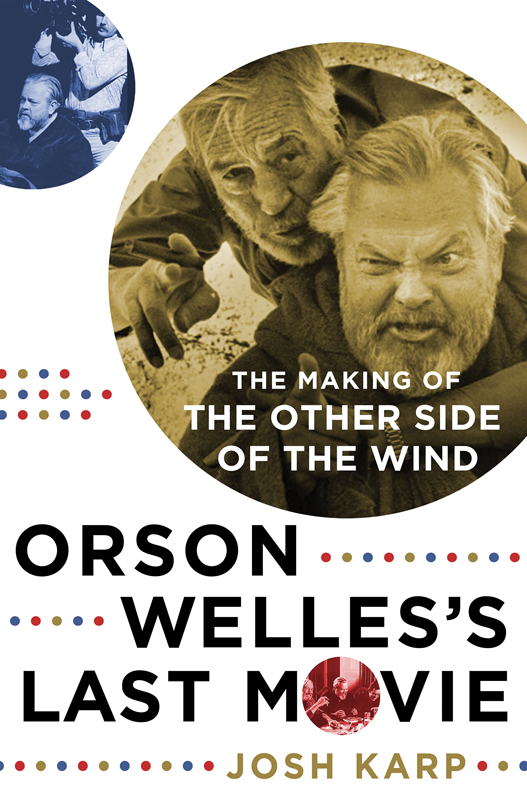Contents
Guide

Th e author and publisher have provided this e-book to you for your personal use only. You may not make this e-book publicly available in any way. Copyright infringement is against the law. If you believe the copy of this e-book you are reading infringes on the authors copyright, please notify the publisher at: us.macmillanusa.com/piracy.
For my fathera lover of the absurd, the eccentric, and the larger-than-life
A director makes only one movie in his life.
Then he breaks it into pieces
and makes it again.
Jean Renoir
Orson would have started hereat the endwith the death of his main character. If this were a movie, and Orson were directing, it might well have begun like this.
First, a new day begins, with an opening shot of a cloudless Dodgers-blue sky and a magni fi cent sun shining, a ft er which we cut to the familiar palm trees that adorn a mansion-lined Beverly Hills street. NowOrsons voice:
It is seven thirty A.M. , October 10, 1985, and this is Roxbury Drive in Beverly Hills, California. They call it the Street of the Stars. Its the kind of place where the hero of our story might livegiven that he was a larger-than-life figure of Hollywoods golden era.
We travel past mansion a ft er mansion, with Orson pointing out that each is someplace where our main character didnt live. Places such as Jimmy Stewarts Tudor, Lucille Balls colonial, and Jack Bennys place with the big bay windows.
No. He didnt live in any of these homes.
We see lawns being watered, men retrieving newspapers, and hedges being clipped by uniformed landscapers. Orson explains that in 1985 nobody is working with a trainer or going to yoga at seven thirty A.M. Instead, the old stars who live in these houses are likely in bed or sitting by their pools, eating so ft -boiled eggs, grapefruit, toast with marmalade, and co ff eeall served o ff silver trays by a member of their sta ff .
Our story, Orson explains, doesnt start here. No, it begins a few short miles (but a world away) northeast at the other end of Sunset Boulevard in West Hollywood. So we leave Beverly Hills, until the camera captures Sunset Boulevard landmarks such as the Chateau Marmont, Sunset Tower, Whiskey a Go Go, and Trocadero. Soon there is a le ft turn, heading a block or two up above Sunset and Hollywood Boulevards to a less swanky neighborhood made up of smaller mansions, large but ramshackle homes, and the kinds of three- fl oor apartment buildings where one can imagine fading stars, of the Peter Lorre variety, living in their decline.
Th en the camera stops and focuses on a small but beautiful, white-pillared Georgian with a wrought-iron fence.
Well, Orson would say with a sigh, here we are: a long way from Beverly Hills at this lovely but modest home on North Stanley Avenue, where our subject lives. Though its hardly Roxbury Drive, it has some trappings of a stars home: a beautiful garden in front, spraying red and pink roses across the white exterior; and out back there is a guesthouse and a lovely pool. But, no, you wont find our hero floating dead in the water like Sunset Boulevard s Joe Gillisthe screenwriter who always wanted a pool and finally got one. No, our hero never wanted money, or a mansion, and definitely not a pool. He didnt want any of that. Instead, he was simply a poor slob who just wanted to make pictures.
And it is here, at this house, on North Stanley Avenue, that our story ends and, thus, it also begins. Lets go in.
Th e camera leads us in an open front door, down a sunny hallway, through a living room, and into the kitchen, where a white-coated houseman is cleaning up last nights dinner: empty bottles of old wine; a standing rib roast, picked clean; a vast empty salad bowl; a crystal dish smeared with cocktail sauce and fi lled with shrimp tails; and ashtrays brimming with the wide stubs of fat Cuban cigars.
A ft er exiting the kitchen, we walk up a staircase, soon following a faint ribbon of smoke. As the smoke gets thicker, we follow it upstairs and into a bedroom turned o ffi ce. Th ere is a bookshelf fi lled with scripts. A fi lm editing table. A still camera. An easel and some paints. Th en there is the source of the smoke: an ashtray sitting on a card table that also holds a typewriterwhich the camera closes in on to reveal a silver tag screwed to its side, reading: Property of Columbia Pictures. Panning up, we see paper in the typewriter, then pull back to see a mane of dark graying hair tossed forward on the page. Farther back still, we see the hair sits on the head of a gigantic man in a purple robe who is facedown on the keyboard. Th en, Orson continues:
And so we begin here, at the end, October 10, 1985, at this home on North Stanley Avenue, with the death of our main character. Myself. Your obedient servant: the late Orson Welles.
During my seventy years I said many things. Because I was Orson Welles, many of them were written down by reporters, friends, film students, enemies, worshippers, biographers, cineastes, and critics. I confess that much of it was fiction created to protect myself or burnish my legend by creating an air of mystery. Sometimes it was simply for my own amusement. But if youll allow me to indulge in the utterly narcissistic act of quoting myself, I want to share something I said in candor and which seems well suited to the moment.
We are born alone, we live alone, and we die alone. Only through our love and friendship can we create the illusion that for the moment we are not alone.
I suppose I was right. Because there I ammost certainly dead and clearly alone. The irony isnt lost on me. I can assure you of that.
Yet there is also something else important I want you to take away. I made my living as an actor and film director. My career was built on creating illusions for others and myself.
And thus it was fifteen years earlier that I had just begun work on one of my greatest acts of creating such illusions to prove that I was anything but alone. I was making a movie
It was 1970. Id just returned to Hollywood after more than a decade in Europe, determined to make an innovative comeback movie about a legendary director who returns from a decade of self-imposed exile in Europe, looking for money to complete his innovative comeback movie.
Some will say it was autobiographical. Others will call it an expos about Hollywood in the early 1970s. There will be those who think its a big fuck you to the studios or revenge against Ernest Hemingway. A few believe it was a way of turning my girlfriend into a movie star, or even some type of Ponzi scheme. Most of all, people will claim it was more than a movie. That it was a final artistic statement; a bookend to Citizen Kane; and the only thing keeping me alive. Were they right? Well, I suppose thats the question. But, for now, Ive told you enough. From here forward, I will let you hear the story of Th e Other Side of the Wind told through the eyes of those who were there and some who werent. I will let you listen to those perspectives and viewpoints. Because Ive found out that it is the only way to see if we can understand art, behavior, and life. And as the jury, I call upon the best people I can think ofthe individual members of the audience. They are the ultimate judgeand always will be.
